Care home marketing trends: Search driving traffic
Occupancy rates in care homes are a challenge for marketing teams. While there is a need to create more beds due to an aging population, it seems that inflation and the rising cost of living means the beds aren’t filling. So, looking to 2024, what are the best ways to stand out in a competitive and challenging marketplace?
This is where learning from the industry can help. Based on anonymised data from our call tracking software, we’ve found out what is and isn’t working for care home marketing teams.
Here are our top takeaways on the channels that are great for driving calls and enquiries for care home marketing teams.
Call to website visit ratio has decreased
The visitor to call ratio across the industry is down 5.5% year-on-year. This ratio is all about how many people are landing on your site versus making a call. To put it simply, it’s all about measuring intent.
With website visitors up but calls down, it suggests that it takes more visits to a website before prospects call. So, building trust is crucial. Those care seekers need to be able to envisage themselves or their loved one in the care home before choosing to pick up the phone.
Social media platforms like Facebook are key to building this trust. As users choose to share their experiences with their personal online communities, this content provides an authentic insight into individual care homes – and what life is like for residents. As a result, potential customers researching new care homes will begin to formulate a perception of how they and their loved ones could benefit from the environment.
With website visitors up but calls to care homes down, it suggests that it takes more visits to a website before prospects call. Building trust is crucial for care homes.
What channels are driving website traffic?
Year on year, website visitors grew by 8%, but what channels were driving this growth? And, what channels should you be investing in next year? Here are the three biggest drivers of website visitors:
- Direct: 32% of the traffic
- Organic: 29% of the traffic
- PPC: 25% of the traffic
Unsurprisingly, Google organic and paid search are key drivers for website traffic, with pay-per-click (PPC) achieving a 5% year-on-year growth. However, our data shows that it is taking 28% longer on average from enquiry to admission compared to last year.
There are many reasons this could be, including resource constraints and a longer decision process as individuals undertake greater levels of research – both on and offline – before taking their next step. Our experience in the sector suggests there could be a multitude of variables at play here, from researching a broad number of options through to ensuring individual care homes can meet specific needs.
But for marketing teams the focus is on:
- Showcasing how care homes can meet the needs of care seekers,
- Understanding what content their target audience are engaging with, and
- What is the ideal customer journey.
Once these are understood it’s about optimising this journey so the move-in rates are where they need to be.
Our data shows that it takes 28% longer on average from enquiry to admission compared to last year.
An interesting time for care home PPC marketing
In 2023, PPC drove 25% of website traffic, demonstrating a notable increase on 2022 where a fifth of visits were owing to this channel. PPC continues to be a valuable source of enquiries in care home marketing, with many homes increasing spend in this area.
However it’s important to highlight that despite an increase in spend, PPC visits have been declining since the start of the year. This shifting performance creates an interesting landscape for marketers, with several factors potentially impacting their results in a negative way:
- Firstly, is PPC spend being allocated effectively? By reviewing the keywords that are being bid on and ensuring budget is allocated to the most relevant for their objectives, marketers can better optimise their budgets.
- Similarly, targeting ineffective keywords could waste budget and reduce campaign impact. Aside from spend, marketing teams should ensure their ads and landing pages are optimised to ensure the best results and achieve greater conversions.
In a time where marketing budgets are stretched, making sure your PPC campaigns are optimised correctly is key. It should be about bidding on keywords that convert to calls, retargeting them after an initial call, and then turn into quality enquiries, not just traffic. This then needs to convert into an increase in occupancy rates as well.
The marketing channels that drive calls to care homes
Customers looking at care homes will often want to talk to someone before making a sensitive and difficult decision. So, for marketing teams this means understanding where your calls are coming from will be key to remain competitive and addressing the challenge of occupancy rates.
From our data we’ve seen that the main source of calls are:
- Google organic: 45% of calls
- PPC: 18% of calls
This isn’t just this year. When we compare the drivers of calls this year to last, we see an 11% growth year on year for organic search and a 24% growth year on year for PPC.
Looking to next year, organic search and paid search will both be key players in driving both website visitors and calls. But the focus should be on making sure your website visitors have a good experience on site, can find the information they need, and convert to calls from there.
Organic search and paid search will both be key players in driving both website visitors and calls. But the focus should be on making sure your website visitors have a good experience on site, can find the information they need, and convert to calls from there
Get the complete insight from our latest report
Looking to understand about the role other channels play in visits and calls? Download the full report today to learn the four vital trends that will impact marketing for care homes next year.

Download our latest report and get the insights you need to help guide your care home marketing strategy, and increase enquiries and move-ins.





